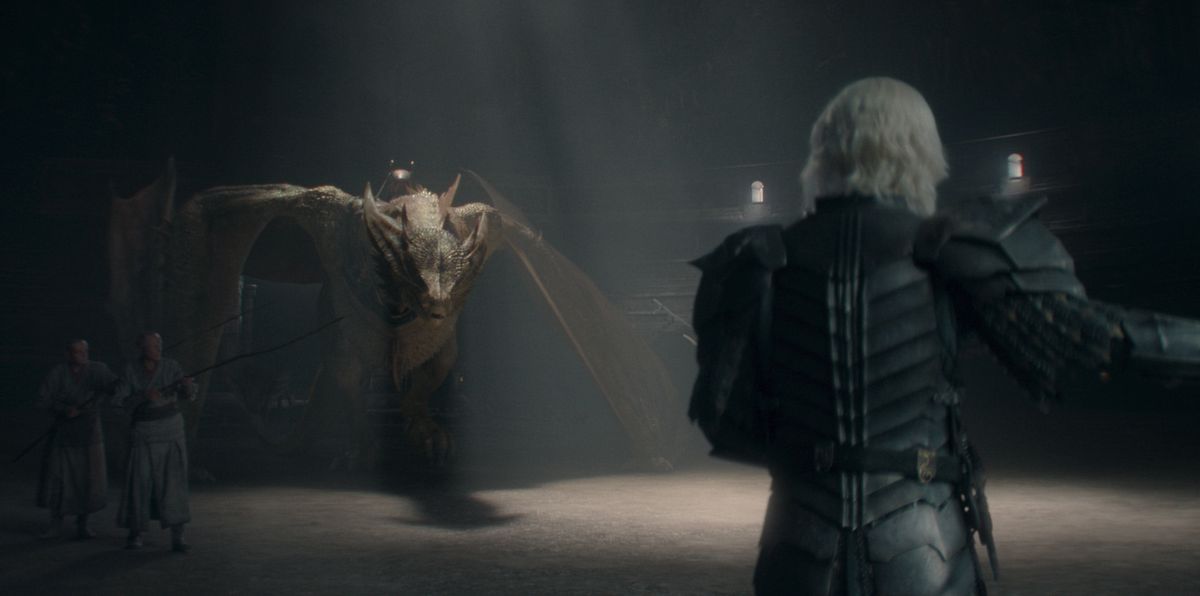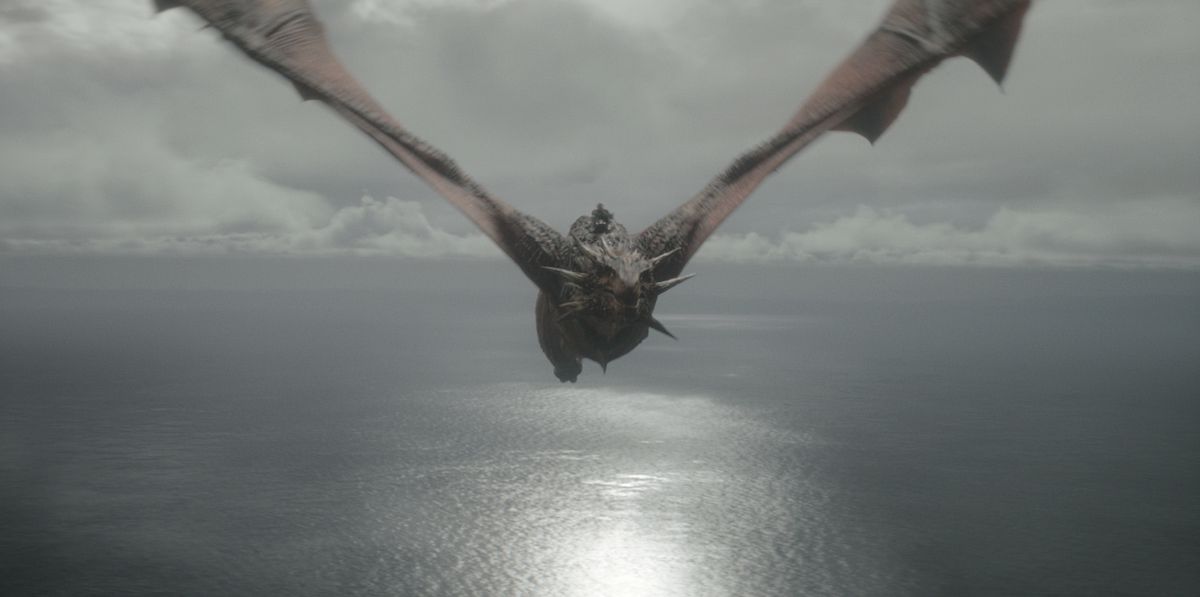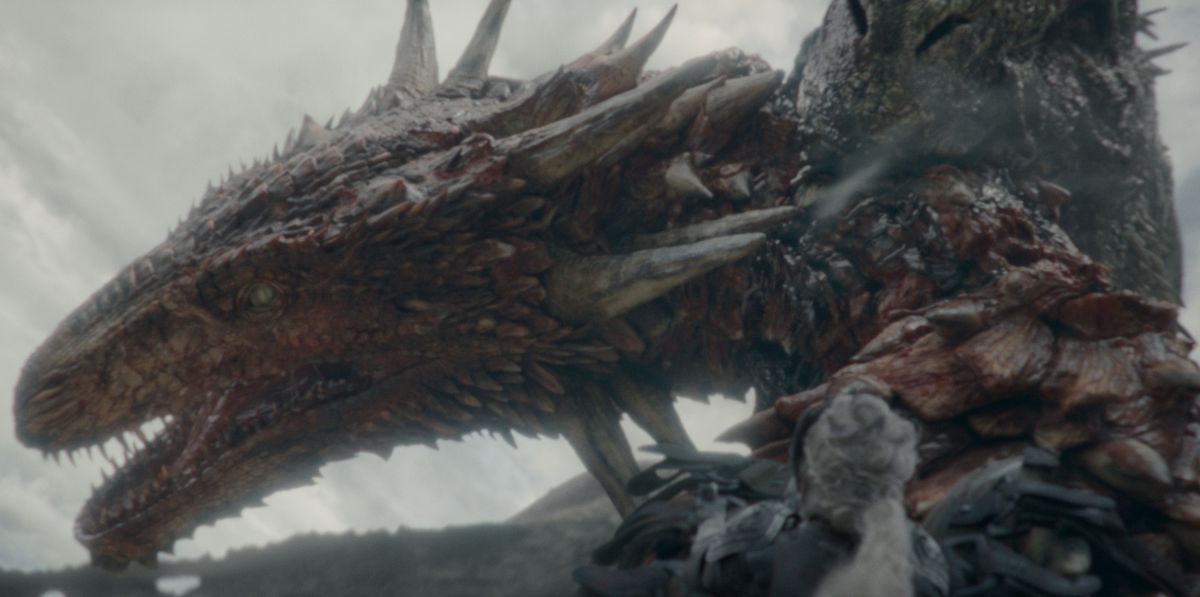House of the Dragon’s epic dragon battle was all about the details
Designing an adult dragon hasn’t changed much since the last few seasons of Game of Thronesbut pull a dance with dragons? A completely different and much more complicated story, says the VFX team behind House of the Dragon season 2.
Sunday night’s fourth episode brought the Black-Green feud to Rook’s Rest for one of the franchise’s most ferocious hours. What the episode lacked in the stifling scale of Hardhome, showrunner Ryan Condal and director Alan Taylor made up for with big, flippin’ dragon action. Aegon, riding Sunfyre, arrives at Rook’s Rest to lay waste to a helpless human army. Rhaenys, riding Meleys, shows up to stop the bloodthirsty boy king. Then Aemond and the elder dragon Vhagar enter the fray, causing chaos as dragons fall, riders die, and explosions wreak havoc. In painting a picture of the scene for VFX supervisor Dadi Einarsson, Condal compared the effect of Aegon’s dragon crash to a napalm drop and the entire encounter to one of the most heartbreaking moments in history.
“The subtext of the scene is: It’s a border,” Einarsson says. “It’s all hand-to-hand combat, but this is like they’re experiencing nuclear war for the first time.”
Image: HBO
Tom Horton, House of the Dragon‘s VFX producer, says the dragon fight in Rook’s Rest — which at one point becomes 12 minutes of nonstop CGI action — “was the most difficult sequence. It was the one we finished last.” The process began with considering characters; audiences were familiar with the look and feel of Drogon, Rhaegal, and Viserion from Game of Thronesand designs that go back in time to the era of House of the Dragon. But Season 2 demanded even more attention to personality and rider dynamics. The dragons had to be “characters in the show, not just monsters or vehicles,” Einarsson says. “And the (fight) scene amplifies and exaggerates the character traits that Ryan had described to us.”
Through performance and often microscopic animation choices, Einarsson and VFX producer Tom Horton aimed to bring their fighter pairings to life, raising the stakes of the fight. For Rhaenys and Meleys, the team wanted to create “an immense sense of foreboding sadness as they’re leaving. They’re going into the fight with dignity. (…) We tried to kind of mirror Meleys’ character through Rhaenys and their relationship, how they interact with each other. It’s kind of a stoic, quiet, regal character.”
Sunfyre presented another challenge to the reality of Westeros, Horton says. Described by George R. R. Martin’s Fire & Blood historian and storyteller as one of the most beautiful dragons that ever existed, the team searched the animal kingdom for reference points for animals that were naturally brightly colored or iridescent without looking “fantasy.” In short, they spent months looking at frogs. “But the bigger they get, the more they (usually) become dull and brown, and the bigger and bumpier they get. The trick was to find something that could be scaled to dragon size.”


Images: HBO
And then there was Vhagar, the old matriarch, who Condal would say “lived a lot longer than he should have.” In addition to her literal wing deteriorating with age, the team wanted the battle-ready Vhagar to feel like a big grouch. “The physical state of the dragon often dictates what the dragon does,” Horton says.
“She’s a grumpy, angry old thing,” Einarsson adds. “She just wants to go out there and kill. So when they get there and she finally sort of waddles up to this huge thing that she is, when Aemond finally tells her ‘dracarys,’ she just goes right up to them and just shoots them out of the sky. She takes Meleys’ life with pleasure.”
To capture the scale and impact, Einarsson and the crew were meticulous with every wingbeat. With larger dragons like Vhagar, viewers should feel the force of a single flap that sends wind across the land as she rises above the treetops. Smaller dragons like Sunfyre or Jacaerys’ Vermax have faster movements, allowing them to rocket through the air but with less impact on the environment. Horton says the House of the Dragon The team went above and beyond almost any job it’s worked on in terms of building CG models for the dragons, intricately detailed skeletons and musculature that are “huge to render” and working with VFX houses around the world, who provide secondary animation on top of the models, making it a monumental task. But it’s worth it: while there is a lot of physics-based simulation used to create wing vibrations to create the finished dragon effects, the workflow is set up to allow for a huge amount of tweaking that no one watching will ever notice.
“I didn’t even think we could adjust that much,” Horton says. “‘This shoulder lift here, but there’s this bone!’ They’re all talking about how this bone would overlap with the tendons, and they’re getting a little too tense too early and… Jesus, the anatomy and the muscularity… We’re really going to the level of detail that’s in the model.”

Image: HBO
All considerations about the great dragons collide for the most breathtaking moment of episode 4: when Aemond and Vhagar surprise a seemingly triumphant Rhaenys and Meleys with another battle. The elder beast ultimately tears Meleys to death and, with no other option, Rhaenys falls gracefully.
Horton says the VFX team worked tirelessly with Condal, Taylor and editor Katie Weiland to refine the moment of connection between Meleys and Rhaenys so that the futility of the fight would shine through. Early versions of the scene focused on Meleys being attacked by Vhagar, without a more overt cut to Rhaenys. “We rendered that and we cut that together, and we realized, Hey, are we missing something?,” Horton says. “’We (wanted to) pull the camera back. Then we tried to bite at different points and give reactions.
“It was really about finding that emotional sweet spot where we see the eye. I think even when we finally got it down, there was one thing we had to tweak. I really wanted the eye to close at that point — we needed that connection. So it was so finely tuned in timing, emotionally, to get the right execution. With actors, you do about 12 takes to hit the points, and we probably did a similar number, but in CGI, back and forth. That’s obviously very complicated, because it’s a CGI creature and we’re working with companies in other countries.”
For Einarsson and Horton, the biggest difference between House of the Dragon seasons 1 and 2 is a leveling up of location shooting. The types of scenes that were previously produced with an LED backdrop on a “volume” Stages were shot more often on location in Season 2, with constructed sets (and hours spent dragging the crew into the mountains). Staging the dragon scenes required an equal sense of reality – if Sunfyre were to fall from the sky, it absolutely had to feel like “a 747-sized creature smashed into the ground.”
“From the beginning, all the producers and all the directors, everyone was completely enamored with making an epic season,” Einarsson says. “There was no compromise on that.”
